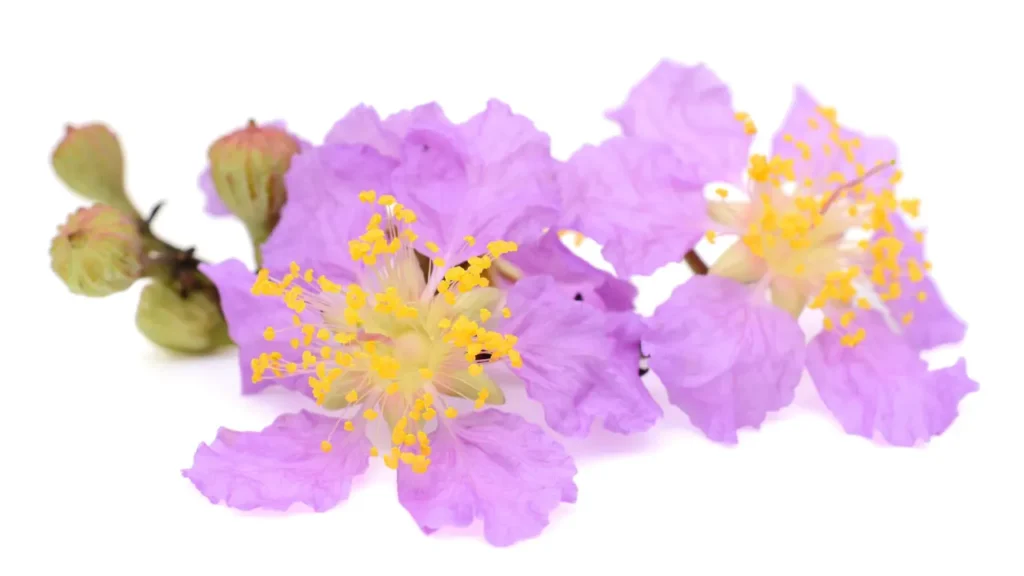A tropical plant native to Southeast Asia called banaba (Lagerstroemia speciosa) has long been used in traditional medicine to treat diabetes and its symptoms. Its leaves contain a number of bioactive substances, including triterpenoids, ellagitannins, and corosolic acid, which have caught the interest of researchers due to their possible health advantages. The chemistry of banaba, its physiological impacts on the body and brain, as well as the best dosage, side effects, and drug interactions, are all covered on this page.
You May Also Like:
Energize Your Life with the Healing Magic of Curcumin Extract
Battle of the Brain Boosters: Brain MD Omega 3 Power vs. Kori Krill Oil Mind & Body
BANABA: Benefits, Dosage, Side Effects, Drug Interactions, And Other Important Information is an original (NootropicsPlanet) article.
Nature of Banaba
A native of Southeast Asia, the banaba (Lagerstroemia speciosa) is a tropical deciduous tree most common in the Philippines, India, and Malaysia. The tree, which may reach a height of 20 meters, is distinguished by its wide, oval-shaped leaves and stunning clusters of blooming purple-to-pink flowers. Banaba has been used in traditional medicine for many years to treat diabetes, kidney illness, and obesity, especially in the Philippines and other Southeast Asian nations.
The therapeutic benefits of the banaba tree are primarily derived from its leaves, which are rich in bioactive substances such as corosolic acid, ellagitannins, and triterpenoids. These substances have shown blood sugar-lowering, anti-inflammatory, and antioxidant effects, which add to the possible health benefits of taking banaba supplements.
Banaba is used medicinally but has cultural and ecological value in its home countries. The tree’s colorful blossoms draw pollinators like bees and butterflies, while its leaves give a variety of insects and animals food and cover. The banaba is widely used in landscaping because of its eye-catching blossoms and rich foliage. The banaba tree’s wood is also used to make furniture, housing, and other wooden goods.
In conclusion, banaba is a valuable plant with a long history of use in Southeast Asia’s traditional medicine. Its bioactive components, including corosolic acid, ellagitannins, and triterpenoids, may have health advantages and have attracted attention in the scientific community for the creation of dietary supplements and conceivable medicinal uses.
Health Benefits of Banaba
Supplementing with banaba has been linked to several health advantages, such as:
- Blood sugar control: Studies have indicated that banaba increases insulin sensitivity and decreases intestinal glucose absorption in people with type 2 diabetes (Miura et al., 2006; Hattori et al., 2003).
- Weight loss: Banaba’s effects on blood sugar may help people lose weight by lowering their appetite and increasing their sense of fullness (Stohs et al., 2012). Additionally, the activation of AMPK by corosolic acid may cause an increase in fat oxidation and decrease fat storage, which would help people lose weight (Li et al., 2006).
- Antioxidant and anti-inflammatory effects: According to research by Hayashi et al. (2002), Kusirisin et al. (2009), Craft et al. (2012), oxidative stress and inflammation are linked to a number of chronic diseases, including diabetes, cardiovascular disease, and neurodegenerative disorders. Banaba may help reduce these conditions.
- Improved cognitive function: Banaba’s antioxidant and anti-inflammatory properties may also help improve brain health and cognitive function because these properties are linked to improved cognitive function and decreased risk of neurodegenerative diseases (Craft et al., 2012).

Chemistry of Banaba
A wide variety of phytochemicals found in banaba leaves may offer health advantages. The following are a few of the main bioactive substances discovered in banaba leaves:
- Corosolic acid: Corosolic acid, a triterpenoid molecule, is thought to be the main compound in banaba that lowers blood sugar. According to studies, it can facilitate glucose uptake into cells and exhibit insulin-like activity (Miura et al., 2006).
- Ellagitannins: According to Hayashi et al. (2002), these polyphenolic chemicals, which include Lagerstroemin and Flosin B, have anti-inflammatory and antioxidant activities.
- Triterpenoids: According to Kusirisin et al. (2009), Lagerstroemia speciosa contains various triterpenoid substances with antioxidant and anti-inflammatory properties, including maslinic acid and arjunolic acid.
Physiological Mechanisms of Action
Banaba’s blood sugar-lowering and antioxidant capabilities are related to its main mechanisms of action on the body and brain. These mechanisms are explained in the sections that follow.
- Blood sugar regulation: Corosolic acid, the main compound in banaba, has been demonstrated to increase the absorption of glucose into cells by triggering the enzyme 5′ adenosine monophosphate-activated protein kinase (AMPK) (Miura et al., 2006). According to Stapleton et al. (1999), activating AMPK improves glucose transport and insulin sensitivity, boosting cell uptake of glucose and lowering blood sugar levels. Furthermore, alpha-glucosidase, an enzyme that converts carbs into glucose, may be inhibited by banaba, reducing glucose absorption in the intestine (Hattori et al., 2003).
- Antioxidant and anti-inflammatory benefits: Banaba contains ellagitannins and triterpenoids, both of which have been found to have these effects. These substances have been shown to suppress pro-inflammatory cytokines, lower oxidative stress, and scavenge free radicals (Hayashi et al., 2002; Kusirisin et al., 2009). Improved brain health and cognitive performance and a decreased risk for chronic diseases, including diabetes, cardiovascular disease, and neurodegenerative disorders, have all been associated with decreased inflammation and oxidative stress (Craft et al., 2012).


Optimal Dosage of Banaba
The ideal banaba supplement dose may change according to a person’s health status, weight, and intended health results, among other things. According to Stohs et al. (2012), standardized banaba extract dosages in human investigations typically range from 16 to 48 mg daily and include 1% to 2% corosolic acid. In certain trials, higher dosages have been used without causing any negative side effects, but further research is required to determine the ideal dosage for various demographics and health results.
Side Effects of Banaba
When used in the recommended amounts, banaba supplementation is usually considered safe for most people. However, certain potential negative consequences have been noted, such as:
- Hypoglycemia: Banaba’s blood sugar-lowering actions can result in low blood sugar (hypoglycemia) in some people, especially those who have diabetes or are taking blood sugar-controlling drugs. Hypoglycemia can cause confusion, sweating, headaches, and dizziness. Before beginning banaba supplementation, it is crucial to check blood sugar levels and get advice from a healthcare provider to reduce the danger of hypoglycemia.
- Digestive discomfort: When using banaba, some people may develop gastrointestinal discomfort, including nausea, diarrhea, or stomach pain. These adverse reactions are typically minor and may go away with continuous use or a dosage reduction.


Potential Substance Interactions with Banaba
The following medicines or substances may interact with banaba:
- Diabetic drugs: When combined with diabetic medications like insulin or oral hypoglycemic agents, banaba’s blood sugar-lowering properties may have additional effects and could make hypoglycemia more likely. If taking blood sugar control drugs, speaking with a healthcare provider before beginning banaba supplementation is crucial.
- Anticoagulant and antiplatelet drugs: When combined with anticoagulant or antiplatelet drugs such as warfarin, aspirin, or clopidogrel, banaba may have blood-thinning effects that could raise the risk of bleeding. If you take these medications, speak to a doctor before taking banaba.
Best Responsible Uses of Banaba
The following best practices can assist ensure appropriate use and maximize possible health advantages when considering banaba supplementation:
- Before beginning a banaba supplementation regimen, especially if you are using drugs for blood sugar regulation or other medical issues, speak with a healthcare provider.
- To guarantee constant dosage and efficacy, pick a reputable brand of banaba extract that is standardized and has a specific quantity of corosolic acid.
- If using banaba to regulate blood sugar, monitor blood sugar levels frequently and adjust the dosage with the help of a healthcare expert.
- Recognize possible side effects and drug interactions, and inform a healthcare provider of any negative consequences.
BANABA:
Conclusion
While some studies have shown promising results regarding the benefits of banaba as a potential supplement for blood sugar regulation and weight management, the overall body of research is limited. More well-designed clinical trials are needed to confirm its effectiveness, safety, and long-term effects. Individuals interested in trying banaba supplements should consult with a healthcare professional to determine whether it is appropriate for their specific health needs and to ensure safe usage, especially if they have any pre-existing medical conditions or are taking medications.


References:
- Banaba: A natural remedy for diabetes and its complications. Retrieved from: https://www.ncbi.nlm.nih.gov/pmc/articles/PMC3468018/
- Antidiabetic effects of Lagerstroemia speciosa L. (Banaba) leaf extract on the postprandial blood glucose and insulin levels. Retrieved from: https://journals.sagepub.com/doi/10.1177/1934578X1801300830
- Lagerstroemia speciosa (L.) Pers. (Banaba) Tea Improves Components of Metabolic Syndrome. Retrieved from: https://www.liebertpub.com/doi/10.1089/jmf.2018.4264
Important Note: The information contained in this article is for general informational purposes only, and should not be construed as health or medical advice, nor is it intended to diagnose, prevent, treat, or cure any disease or health condition. Before embarking on any diet, fitness regimen, or program of nutritional supplementation, it is advisable to consult your healthcare professional in order to determine its safety and probable efficacy in terms of your individual state of health.
Regarding Nutritional Supplements Or Other Non-Prescription Health Products: If any nutritional supplements or other non-prescription health products are mentioned in the foregoing article, any claims or statements made about them have not been evaluated by the U.S. Food and Drug Administration, and such nutritional supplements or other health products are not intended to diagnose, treat, cure, or prevent any disease.
